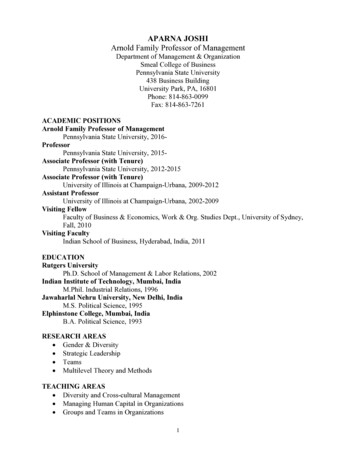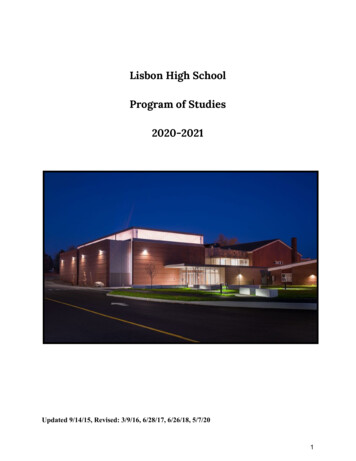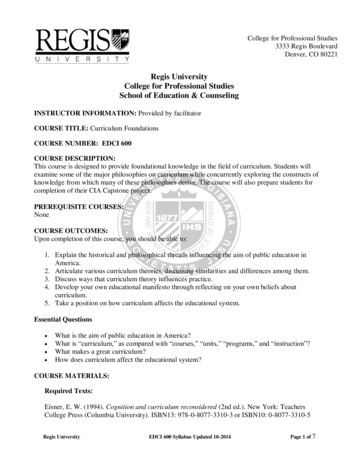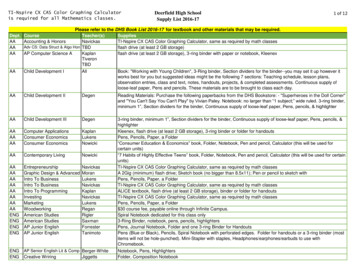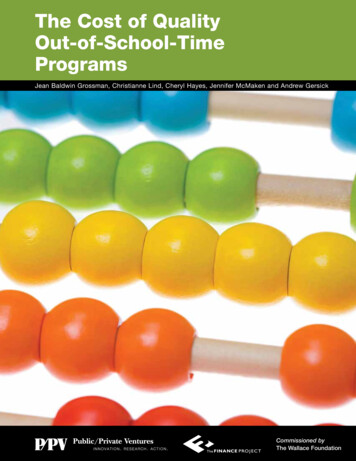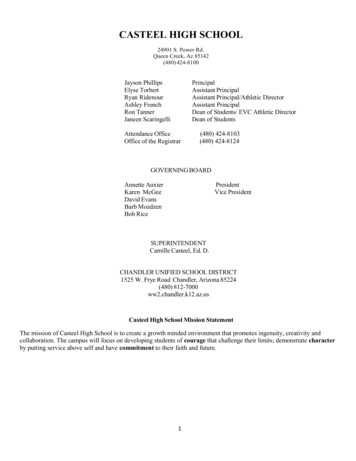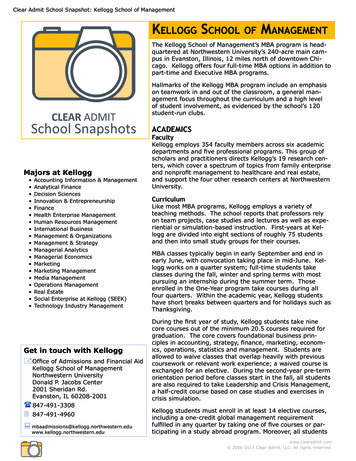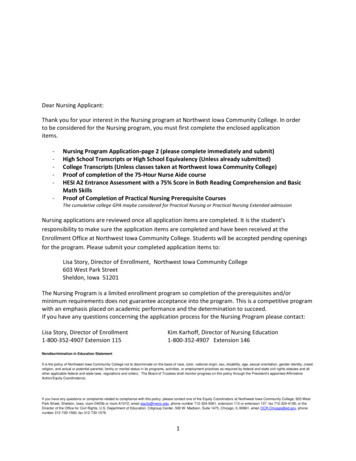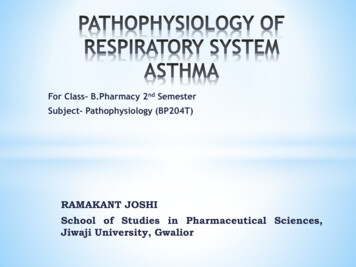
Transcription
For Class- B.Pharmacy 2nd SemesterSubject- Pathophysiology (BP204T)RAMAKANT JOSHISchool of Studies in Pharmaceutical Sciences,Jiwaji University, Gwalior
INTRODUCTION Asthmais a chronic inflammatory disease ofthe airways that causes airway hyperresponsiveness, mucosal edema, and mucusproductionAsthma is characterized by chronic airwayinflammation and increased airway hyperresponsiveness leading to symptoms of wheeze,cough, chest tightness and dyspnoea.
Asthmadiffers from the other obstructive lungdiseases in that it is largely reversible, eitherspontaneously or with treatment. Patientswith asthma may experiencesymptom-free periods alternating with acuteexacerbations, which last from minutes tohours or days.
EPIDEMIOLOGYmany countries the prevalence ofasthma is increasing. In Thisincrease, with its accompanyingallergy, is particularly in children andyoung adults where this disease mayaffect up to 15% of the population. Asthmabeing commonerdeveloped countries.inmore
ETIOLOGY AND RISK FACTOR Asthmaoccurs in families which suggest that itis an inherited disorder. Allergy is the strongest predisposing factor forasthma. Chronic exposure to airway irritants orallergens also increases the risk for developingasthma. Common allergens can be seasonal (eg, grass,tree, and weed pollens, mold, dust, or animaldander).
Excitatorystate (stress ,cry ) Occupational environment factor such as cold air, air pollution,druginfection, Occupational environment Other factor such as cold air ,air pollution,infection, diet
Triggers Allergens Upper respiratory tract viral infections Exercise Cold air Sulfur dioxideDrugs ( BETA blockers,aspirin) Stress Irritants (household sprays, paint fumes)
CLASSIFICATIONAsthma is a complex disorder of theconducting airways that most simply can beclassified as:Extrinsic – implying a definite external cause Intrinsic – when no causative agent can beidentified.
PATHOPHYSIOLOGY Asthma is a complex condition where interaction of genetics andenvironment occurs involving many inflammatory cells which release awide range of variety of mediators. These mediators act on the cells of the airway leading to smooth musclecontraction, mucus hyper secretion, plasma leakage, edema, activation ofcholinergic reflexes and activation of sensory nerves, which lead toamplification of the continuing inflammatory response. The chronic inflammation leads to structural changes, including sub-epithelial fibrosis and smooth muscle hypertrophy and hyperplasia. Thislate process is less easily reversed than the acute changes and might end upwith airway remodeling.
*Exposure to allergens & irritantsIGE stimulationMast cells trienesAir way hyperresponsivenessMucus secretionNon productive coughInflammationBronchospasmShortness of breathWheezing, chest tightness,Peakflow variability
TheCLINICAL MANIFESTATIONSprincipal symptoms of asthma are wheezingattacks and episodic shortness of breath.symptoms include recurrent episodes ofwheezing, chest tightness, breathlessness andcough. Typicalsome instances, cough may be the onlysymptom In cough,with or without mucus production Expirationprolonged.requireseffortandbecomes
DIAGNOSISHistory taking A complete family, environmental, andoccupational history is essential. Family history : History of asthma in family Environmental history : seasonal changes,high pollen counts, mold, climate changes(particularly cold air), and air pollution,
Occupational history : occupation-relatedchemicals and compounds, including metalsalts, wood and vegetable dustMedications (eg, aspirin)Industrial chemicals and plastics, biologicenzymes (eg, laundry detergents), animal andinsect dusts, sera, and secretions.
INVESTIGATIONS Lungfunction tests/ pulmonary functiontest : Shows variable airflow limitationtests :shows increase in the numberof eosinophils in peripheral blood ( 0.4 109/L). Bloodtests The presence of largenumbers of eosinophils in the sputum is amore useful diagnostic tool. Sputum
X-ray : There are no diagnosticfeatures of asthma on the chest X-ray Chest Achest X-ray may be helpful in excludinga pneumothorax, which can occur as acomplication of asthmatests Skin-prick tests (SPT) shouldbe performed in all cases of asthma tohelp identify allergic causes. Skin
Episodicor chronic symptoms of airflowobstruction: breathlessness, cough, wheezing, andchest tightness. Symptoms frequently worse at night or in the earlymorning. Prolonged expiration and diffuse wheezes onphysical examination. Limitation of airflow on pulmonary function testing. Complete or partial reversibility of airflowobstruction, either spontaneously or followingbronchodilator therapy.
Nursing diagnosis: Ineffective breathingpattern related to shortness of breath, mucus,bronchoconstriction, and airway irritantsOutcomes A decreasing respiratory rate to within normallimits. Decreased dyspnoea, less nasal flaring, andreduced use of accessory muscles. Decreased manifestations of anxiety. Oxygen saturation greater than 95%.
Nursingdiagnosis: Impaired GasExchange related to air trapping.Outcomes Decreased inspiratory and expiratorywheezing. Oxygen saturation 90%. pH of 7.35 to 7.45. Usual skin color (no cyanosis). Decreasing dry, nonproductive cough.
MEDICAL MANAGEMENT1.Oxygen : Give oxygen to keep oxygen saturation 95% in allchildren with asthma who are cyanosed (oxygen saturation 90%) or whose difficulty in breathing interferes with talking,eating or breastfeeding.2. Pharmacotherapy: Quick relievers: Used for acute attacks to relieve bronchospasm asand when needed. Salbutamol Terbutaline Adrenaline Aminophylline Preventers: Used for long-term to control the inflammation and toprevent further attacks. - Steroids ( Oral and Inhaled) like prednisolone. - Theophylline
Long-term symptom relievers: Used to relievebronchospasm for longer hours. – Salmeterol – Formoterol – BambuterolAlways use with inhaled Steroids
If the methods of delivering salbutamol are notavailable, give a subcutaneous injection of adrenalineat 0.01 ml/kg of 1:1000 solution (up to a maximum of0.3 ml), measured accurately with a 1-ml syringe. Ifthere is no improvement after 15 min, repeat the doseonce. Magnesium sulfate : Intravenous magnesium sulfatemay provide additional benefit in children with severeasthma treated with bronchodilators andcorticosteroids. Give 50% magnesium sulfate as a bolusof 0.1 ml/kg (50 mg/kg) IV over 20 min.
Oral bronchodilators : Use of oral salbutamol (insyrup or tablets) is not recommended in the treatmentof severe or persistent wheeze. It should be used onlywhen inhaled salbutamol is not available for a childwho has improved sufficiently to be discharged home.Dosage is Age 1month to 2 years: 100 μg/kg (maximum,2 mg) up to four times daily – Age 2–6 years: 1–2 mg upto four times daily.
NURSING MANAGEMENTThe management of asthma includes: Education Environment control Evaluation Emotional support Regular follow-up.
1. Education: The nurse must spend time to clear the misconceptionsabout the disease, sexual bias, non-communicability of the disease, fearof inhalers, steroids, etc.2. Environment ControlIt is the most important factor in the control of asthma. The aim should beto avoid allergens and irritants: Dust mites: Avoid carpets, use plastic covers to pillows and mattresses;and expose to sunlight once a week; wash soft toys periodically; and wetmop the floorings. Cockroach: Cover garbage and unused food containers. Fungus: Attend to damp walls, have good ventilation and clean theshower curtains weekly. Pets: Keep them away from sleeping area, if possible outside the house Avoid strong odors, smoke, mosquito coil burning, and especially tobaccosmoke.
3. Evaluating respiratory status and patients generalcondition Frequent assessment of respiratory pattern. Cyanosis Breath sounds Vital signs Cerebral functions
4. Providing emotional support: Calm and quiet approach Trusting relationship Reassurance Play and recreation Parental participations5. Positioning: Comfortable sitting position and supporting withpillow. Leaning forward with support may be allowed Administering oxygen
6. Administering fluid therapy: During asthma they take less fluid. Vomiting and insensible loss due to hyperventilation. Maintain input output chart7. Maintaining adequate dietary intake: Clear liquids in small amounts. Allergic foods to be avoided. Spicy and gas forming foods to be avoided. Balanced diet.
7. Maintenance of hygienic measures: Routine hygiene care. Dust and allergen free environment. Aseptic technique.8. Supporting parents and family Emotional support Parent participation in care Discuss treatment plan. Health education.
Ineffective breathing pattern related to shortness of breath, mucus, bronchoconstriction, and airway irritants Outcomes A decreasing respiratory rate to within normal limits. Decreased dyspnoea, less nasal flaring, and reduced use of accessory muscles. Decreased manifestations of anxiety. Oxygen saturation greater than 95%.
